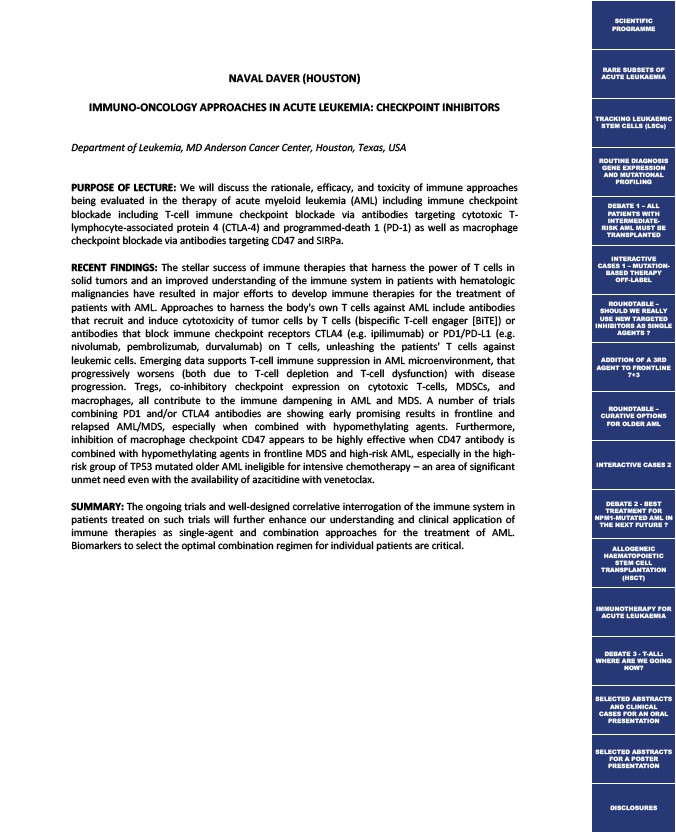
NAVAL DAVER (HOUSTON)
IMMUNO-ONCOLOGY APPROACHES IN ACUTE LEUKEMIA: CHECKPOINT INHIBITORS
Department of Leukemia, MD Anderson Cancer Center, Houston, Texas, USA
PURPOSE OF LECTURE: We will discuss the rationale, efficacy, and toxicity of immune approaches
being evaluated in the therapy of acute myeloid leukemia (AML) including immune checkpoint
blockade including T-cell immune checkpoint blockade via antibodies targeting cytotoxic T-lymphocyte-
associated protein 4 (CTLA-4) and programmed-death 1 (PD-1) as well as macrophage
checkpoint blockade via antibodies targeting CD47 and SIRPa.
RECENT FINDINGS: The stellar success of immune therapies that harness the power of T cells in
solid tumors and an improved understanding of the immune system in patients with hematologic
malignancies have resulted in major efforts to develop immune therapies for the treatment of
patients with AML. Approaches to harness the body's own T cells against AML include antibodies
that recruit and induce cytotoxicity of tumor cells by T cells (bispecific T-cell engager BiTE) or
antibodies that block immune checkpoint receptors CTLA4 (e.g. ipilimumab) or PD1/PD-L1 (e.g.
nivolumab, pembrolizumab, durvalumab) on T cells, unleashing the patients' T cells against
leukemic cells. Emerging data supports T-cell immune suppression in AML microenvironment, that
progressively worsens (both due to T-cell depletion and T-cell dysfunction) with disease
progression. Tregs, co-inhibitory checkpoint expression on cytotoxic T-cells, MDSCs, and
macrophages, all contribute to the immune dampening in AML and MDS. A number of trials
combining PD1 and/or CTLA4 antibodies are showing early promising results in frontline and
relapsed AML/MDS, especially when combined with hypomethylating agents. Furthermore,
inhibition of macrophage checkpoint CD47 appears to be highly effective when CD47 antibody is
combined with hypomethylating agents in frontline MDS and high-risk AML, especially in the high-risk
group of TP53 mutated older AML ineligible for intensive chemotherapy – an area of significant
unmet need even with the availability of azacitidine with venetoclax.
SUMMARY: The ongoing trials and well-designed correlative interrogation of the immune system in
patients treated on such trials will further enhance our understanding and clinical application of
immune therapies as single-agent and combination approaches for the treatment of AML.
Biomarkers to select the optimal combination regimen for individual patients are critical.
SCIENTIFIC
PROGRAMME
RARE SUBSETS OF
ACUTE LEUKAEMIA
TRACKING LEUKAEMIC
STEM CELLS (LSCs)
ROUTINE DIAGNOSIS
GENE EXPRESSION
AND MUTATIONAL
PROFILING
DEBATE 1 – ALL
PATIENTS WITH
INTERMEDIATE-RISK
AML MUST BE
TRANSPLANTED
INTERACTIVE
CASES 1 – MUTATION-BASED
THERAPY
OFF-LABEL
ROUNDTABLE –
SHOULD WE REALLY
USE NEW TARGETED
INHIBITORS AS SINGLE
AGENTS ?
ADDITION OF A 3RD
AGENT TO FRONTLINE
7+3
ROUNDTABLE –
CURATIVE OPTIONS
FOR OLDER AML
INTERACTIVE CASES 2
DEBATE 2 - BEST
TREATMENT FOR
NPM1-MUTATED AML IN
THE NEXT FUTURE ?
ALLOGENEIC
HAEMATOPOIETIC
STEM CELL
TRANSPLANTATION
(HSCT)
IMMUNOTHERAPY FOR
ACUTE LEUKAEMIA
DEBATE 3 - T-ALL:
WHERE ARE WE GOING
NOW?
SELECTED ABSTRACTS
AND CLINICAL
CASES FOR AN ORAL
PRESENTATION
SELECTED ABSTRACTS
FOR A POSTER
PRESENTATION
DISCLOSURES